Move Limit
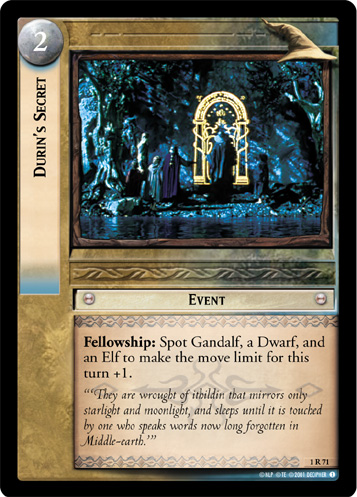
During each of your turns, your fellowship must move once, and may move a number of times up to your move limit.
In a two- or three-player game, your move limit is two. In a game with four or more players, your move limit is equal to the number of your opponents when the game begins. During your regroup phase, you may decide to move your fellowship again, subject to this move limit.
If the move limit is modified for a turn, then that modification is in effect for the whole turn, even if the conditions for the modification change.- move_limit_2 section
The greatest number of turns a player can take in Lord of the Rings is 8: one for each move from site 1 to site 9. Because ending your turn on site 9 wins the game, a much more interesting consideration is the fewest number of turns a player can take to do so. Fellowships cannot attempt to simply walk to Mordor and are instead constrained by the move limit. Moving twice in a single turn is known as a "double move" and the act of doing so is called "double-moving"; due to the frequency of moving twice in a single turn, these terms are often shortened to "double" and "doubling" respectively. Moving three times is known as a "triple move", and so on, although shortening these terms (for example, "tripling") is less common.
The last line of the rules entry is especially noteworthy, and makes move limit modifiers unique. This comes up regularly with Radagast, The Brown (9R+26)
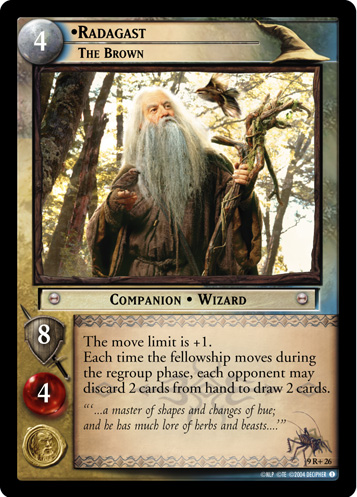 - if the Free Peoples player kills Radagast, they will retain the move limit bonus without giving the Shadow player an opportunity to cycle 2 extra cards.
- if the Free Peoples player kills Radagast, they will retain the move limit bonus without giving the Shadow player an opportunity to cycle 2 extra cards.
While move limit modifiers are unique in that they last for the whole turn, they follow other rules for modifiers: each time the move limit is modified all modifiers are reapplied, and if the end result would be a negative number it is instead zero. While the rules don't say the move limit cannot be zero, there is no way to reduce the move limit modifier below 1 until after the Fellowship has already moved once. The move limit is concerned with how many future moves the Free Peoples is allowed to make, so if a new modifier reduces the move limit below the number of moves the Free Peoples has already made they simply cannot move again; they are not allowed to move backwards.
There are several factors to consider when deciding whether to move in the regroup phase, though which are most important depends on the situation.
- The state of the board - how many minions are alive, how many cards are in your opponents support area, and how many wounds and burdens you have on your Fellowship are important considerations, as well as the health of your opponent's Free Peoples. Just remember that only one companion - the Ring-bearer - needs to survive site 9.
- The state of your deck - By reaching the end in fewer turns, you risk reaching harrowing later sites without the cards needed to survive them. If there are key cards in your deck that you need before you can face your opponent's strategy head on, it may be worth slowing down to find them; if you already have your most important cards on the table then there is less to gain on your next turn anyway.
- The state of your opponent's deck - If your opponent has been able to dish out a high percentage of Shadow cards at the start of the game, it often means the second half of their deck will contain more Free Peoples cards (and vice versa). A condition-heavy Shadow side tends to need time to get through the deck and play those key cards while others may be limited only by the amount of twilight in the pool.
- The state of your hand - If you have a few Free Peoples events in hand, you may not only have the arsenal to survive another move but you may be unable to stop your opponent from doing the same since you'll have fewer Shadow cards to throw at them. Similarly if you have many Shadow cards in hand, you may not be in the best position to move again this turn but will be able to throw your full might at your opponent to force a stop on their turn.
- The state of your opponent's hand - The most important thing to look for here is how many cards your opponent(s) drew after reconciling, and which card (if any) each Shadow player discarded in the process. Estimating how many Shadow cards your opponent has drawn by reconciling is key: the worst case scenario is often 75%, so if you don't think your opponent can cause too much damage with that then you may want to consider making another move. Conversely, if you judge that they're digging through Shadow cards to find what they need for their Free Peoples then a second move may not only help them save their Free Peoples but maximize damage caused with their Shadow side.
- The state of the twilight pool - This can be tricky to gauge and depends heavily on the state of your opponent's hand; a small amount of twilight left means your opponent won't get too much more to work with than if you had moved next turn anyway, but could also indicate that there are more Shadow cards in their hand that couldn't be played (especially if their minions will stop roaming next site). Many twilight tokens, on the other hand, means your opponent will be able to play anything they want next site, but could mean their hand is full of Free Peoples cards and there's nothing to fear.
- The state of the adventure path - Are you ahead or behind? How much twilight will the next site likely provide? Would your opponent be able to double on their next turn? Will minions stop roaming if you move again? Are you and your opponents far enough apart that moving again will have no impact on the outcome of the game? These are some things to think about as you decide whether to make another move.
The move from site 2 to 3 in the regroup phase is safest due to the low twilight, sanctuary healing next turn, and fact that many minions are still roaming at site 3. In general, having 0 or 1 twilight in the pool and no minions on the table invites an opportunity to move again since your opponent will almost always have fewer options now than next turn after cycling through their Free Peoples cards. This is especially true when your opponents' minions stopped roaming this site (since Shadow hands are typically among their strongest at this point, so there may be less to worry about if your opponent couldn't make an impact here) and on site 7 or 8 (when your opponents typically need more cards in hand than one reconcile can provide to use all the twilight the next site would offer).
Cards that alter the move limit[edit]
As stated above, the default move limit is two. There are Free Peoples cards capable of raising that limit, Shadow cards capable of lowering that limit, and sites capable of doing either. Enraged Southron (12C64)
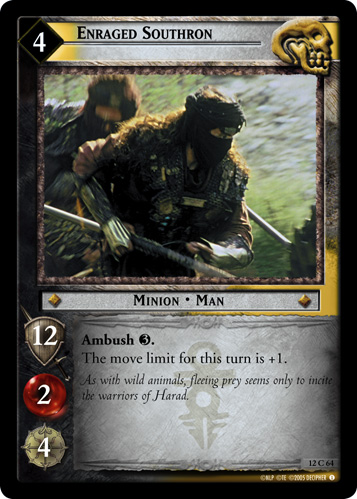 is notable for being the only Shadow card that raises the move limit, while News From the Mark (6R96)
is notable for being the only Shadow card that raises the move limit, while News From the Mark (6R96)
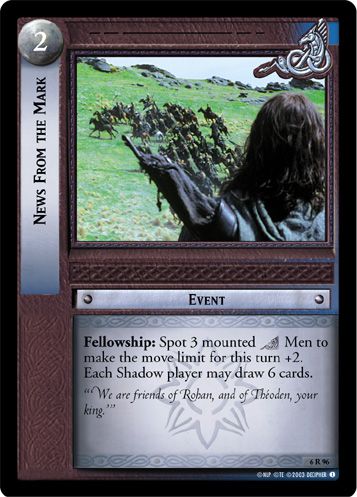 is the only card that can increment the move limit by 2 instead of 1.
is the only card that can increment the move limit by 2 instead of 1.
Note that as long as you are able to pay all costs, some of these actions can be made several times in a single turn. It is often in the best interest of the Shadow player to reduce the move limit as many times as possible to prevent the Free Peoples from being able to modify it back up. Ruined Capitol (7U355)
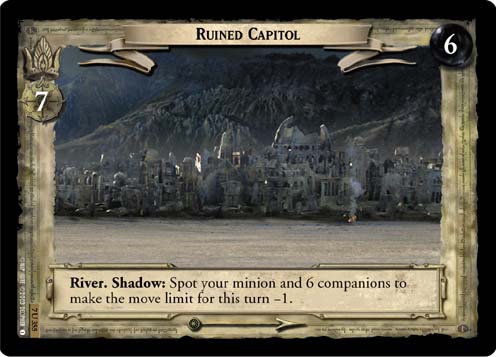 in particular has only a spot cost, so using it several times will apply that many -1 modifiers and can prevent a surprise regroup event such as Last Throw (10C34)
in particular has only a spot cost, so using it several times will apply that many -1 modifiers and can prevent a surprise regroup event such as Last Throw (10C34)
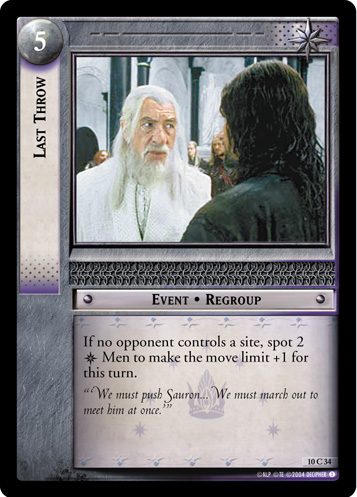 from raising the move limit above 1.
from raising the move limit above 1.
Cards That Add to the Move Limit[edit]
| CardName | Side | Culture | CardType | GameText |
|---|---|---|---|---|
Gift of Boats (1U46)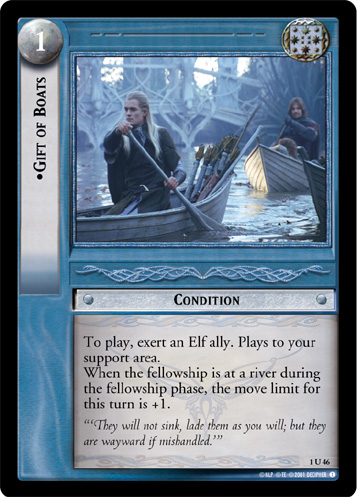 |
Free Peoples | Elven | Condition | To play, exert an Elf ally. When the fellowship is at a river during the fellowship phase, the move limit for this turn is +1. |
Durin’s Secret (1R71) |
Free Peoples | Gandalf | Event | Fellowship: Spot Gandalf, a Dwarf, and an Elf to make the move limit for this turn +1. |
Bree Gate (1U327)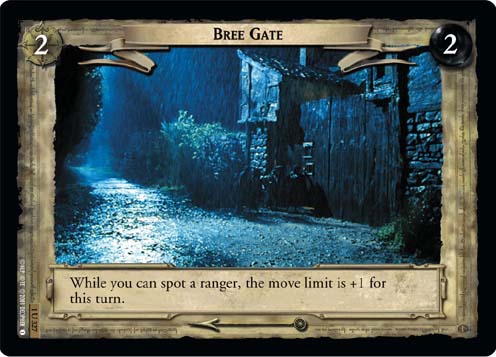 |
None | Site | Site | While you can spot a ranger, the move limit is +1 for this turn. |
Rivendell Waterfall (1U342)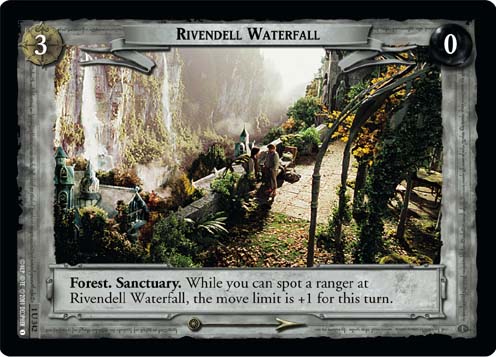 |
None | Site | Site | Forest. Sanctuary. While you can spot a ranger at Rivendell Waterfall, the move limit is +1 for this turn. |
Horse-country (4U326)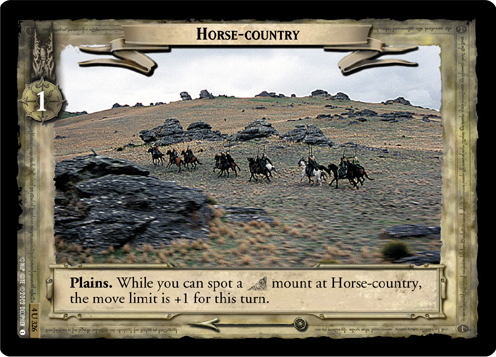 |
None | Site | Site | Plains. While you can spot a |
Derndingle (4U330)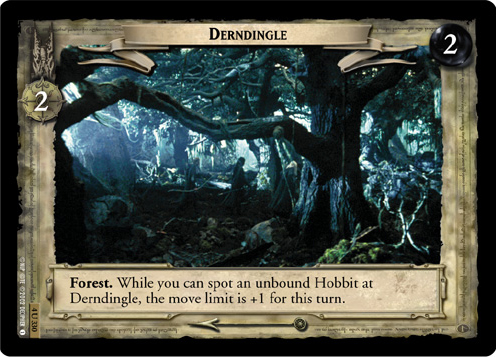 |
None | Site | Site | Forest. While you can spot an unbound Hobbit at Derndingle, the move limit is +1 for this turn. |
Safe Paths (6R44)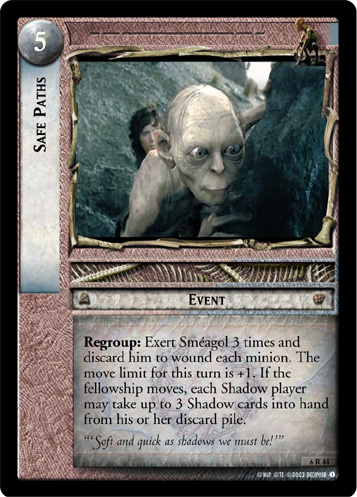 |
Free Peoples | Gollum | Event | Regroup: Exert Sméagol 3 times and discard him to wound each minion. The move limit for this turn is +1. If the fellowship moves, each Shadow player may take up to 3 Shadow cards into hand from his or her discard pile. |
News From the Mark (6R96) |
Free Peoples | Rohan | Event | Fellowship: Spot 3 mounted |
Secret Paths (7R69)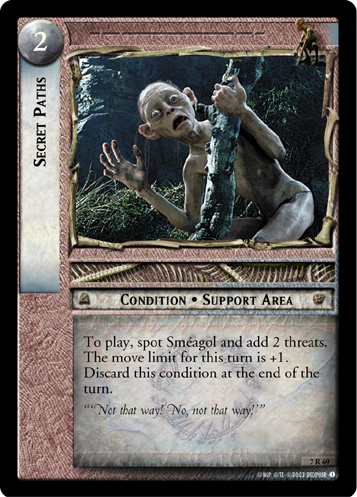 |
Free Peoples | Gollum | Condition | To play, spot Sméagol and add 2 threats.
The move limit for this turn is +1. Discard this condition at the end of the turn. |
Stern People (7R251)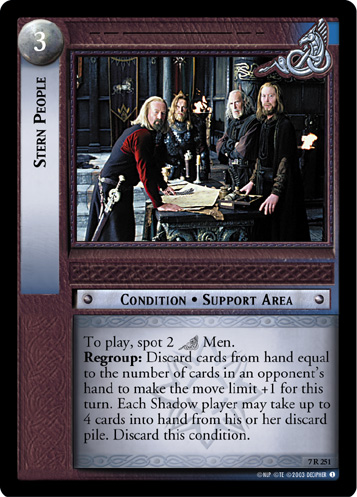 |
Free Peoples | Rohan | Condition | To play, spot 2 |
Tower of Ecthelion (7U340)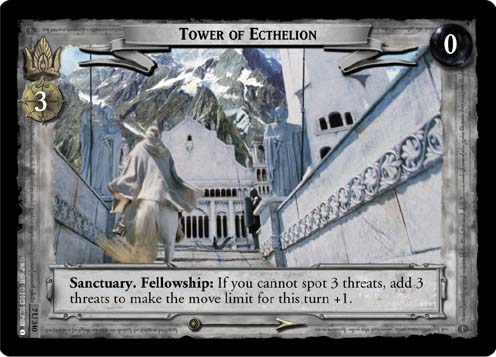 |
None | Site | Site | Sanctuary. Fellowship: If you cannot spot 3 threats, add 3 threats to make the move limit for this turn +1. |
Radagast, The Brown (9R+26) |
Free Peoples | Gandalf | Companion | The move limit is +1. Each time the fellowship moves during the regroup phase, each opponent may discard 2 cards from hand to draw 2 cards. |
Elendil, The Tall (9R+32)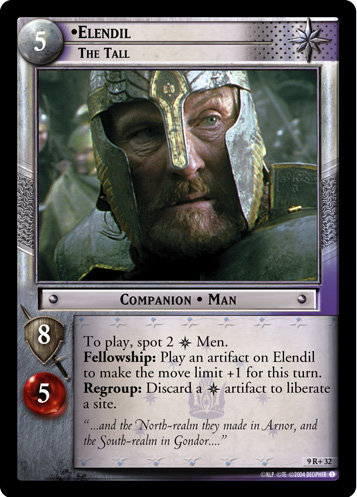 |
Free Peoples | Gondor | Companion | To play, spot 2 Fellowship: Play an artifact on Elendil to make the move limit +1 for this turn. Regroup: Discard a |
Last Throw (10C34) |
Free Peoples | Gondor | Event | If no opponent controls a site, spot 2 |
Riding Like the Wind (11C155)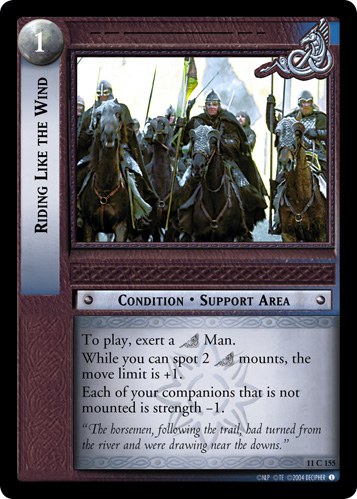 |
Free Peoples | Rohan | Condition | To play, exert a |
Enraged Southron (12C64) |
Shadow | Men | Minion | Ambush |
Théoden, The Renowned (13R137)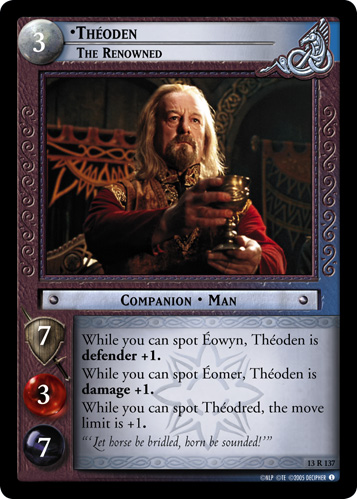 |
Free Peoples | Rohan | Companion | While you can spot Éowyn, Théoden is defender +1.
While you can spot Éomer, Théoden is damage +1. While you can spot Théodred, the move limit is +1. |
Cards That Subtract From the Move Limit[edit]
| CardName | Side | Culture | CardType | GameText |
|---|---|---|---|---|
Traitor's Voice (1U142)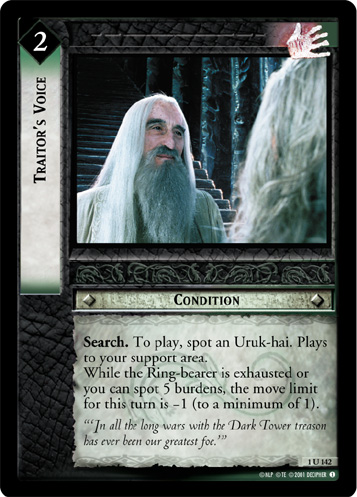 |
Shadow | Isengard | Condition | Search. To play, spot an Uruk-hai. While the Ring-bearer is exhausted or you can spot 5 burdens, the move limit for this turn is -1 (to a minimum of 1). |
The Number Must Be Few (1U260)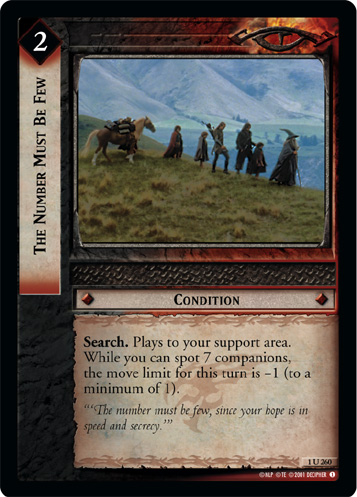 |
Shadow | Sauron | Condition | Search. Plays to your support area. While you can spot 7 companions, the move limit for this turn is -1 (to a minimum of 1). |
Sauron's Defenses (1U274)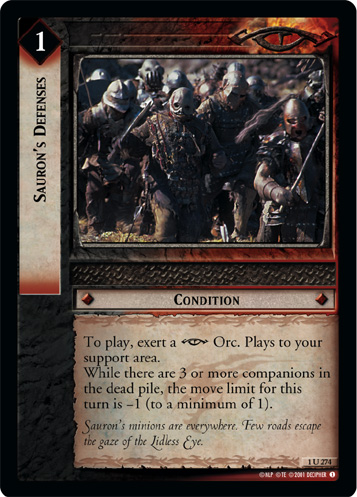 |
Shadow | Sauron | Condition | To play, exert a |
Company of Haradrim (5R71)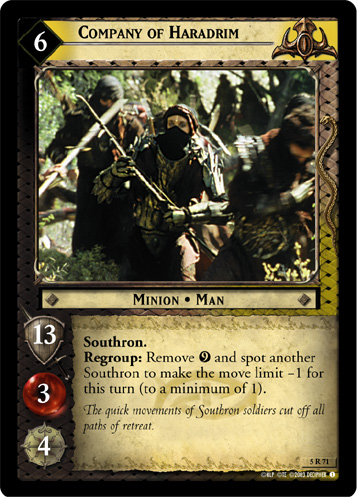 |
Shadow | Raider | Minion | Southron.
Regroup: Remove |
Master Broke His Promise (6R41)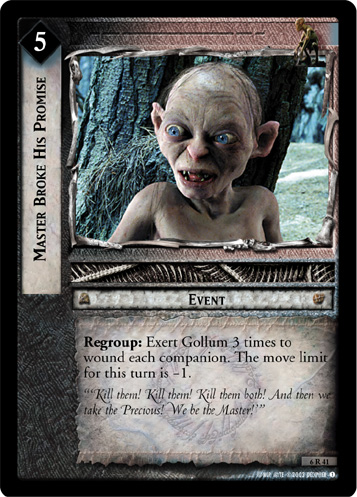 |
Shadow | Gollum | Event | Regroup: Exert Gollum 3 times to wound each companion. The move limit for this turn is –1. |
Great Beasts (7C149)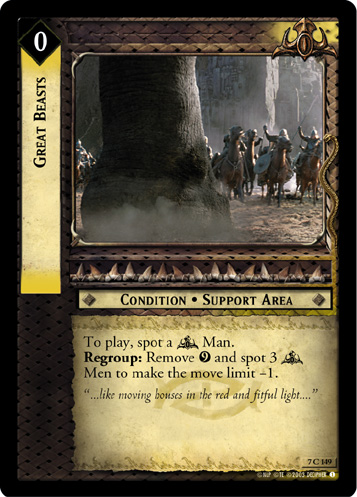 |
Shadow | Raider | Condition | To play, spot a |
Surging Up (7R169)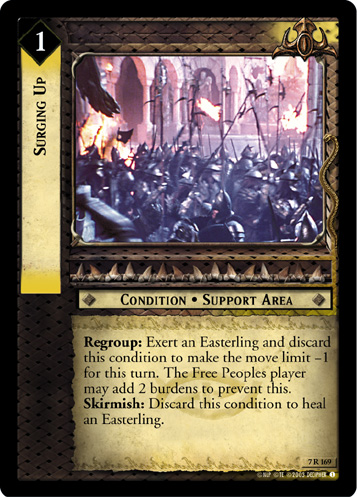 |
Shadow | Raider | Condition | Regroup: Exert an Easterling and discard this condition to make the move limit -1 for this turn. The Free Peoples player may add 2 burdens to prevent this. Skirmish: Discard this condition to heal an Easterling. |
King's Tent (7U335)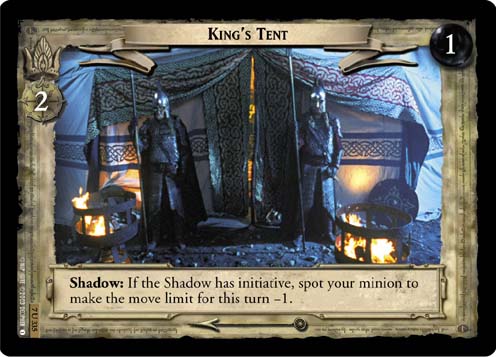 |
None | Site | Site | Shadow: If the Shadow has initiative, spot your minion to make the move limit for this turn –1. |
Ruined Capitol (7U355) |
None | Site | Site | River. Shadow: Spot your minion and 6 companions to make the move limit for this turn –1. |
Gorgoroth Patrol (8U99)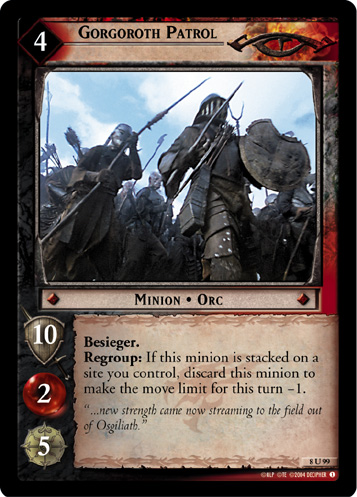 |
Shadow | Sauron | Minion | Besieger. Regroup: If this minion is stacked on a site you control, discard this minion to make the move limit for this turn –1. |
Squad of Haradrim (11U99)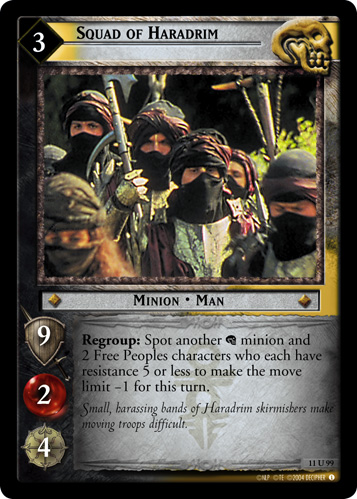 |
Shadow | Men | Minion | Regroup: Spot another |
Swarming Hillman (14R11)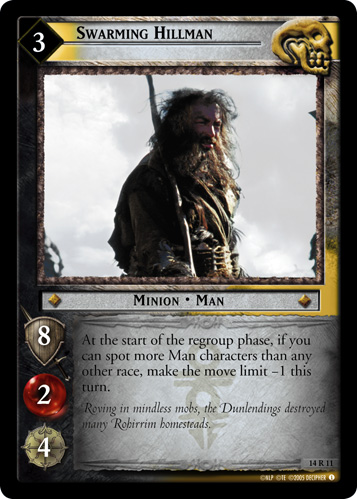 |
Shadow | Men | Minion | At the start of the regroup phase, if you can spot more Man characters than any other race, make the move limit –1 this turn. |
Desperate Move (15R42)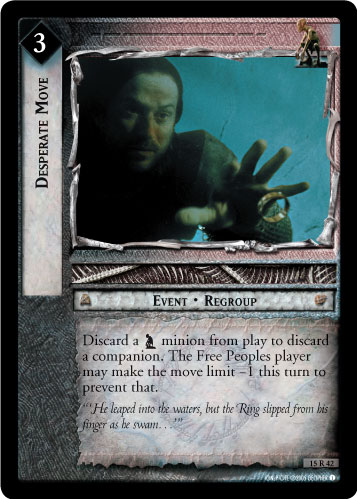 |
Shadow | Gollum | Event | Discard a |
Cards That Force Moves[edit]
Whether or not to move in the regroup phase is a decision that must be carefully weighed by the Free Peoples player. Usually. While the cards above allow the Shadow player to reduce the move limit (effectively forcing the Free Peoples player to stay put), there are others which force the Free Peoples player to move. These actions are still governed by the move limit.
| CardName | Side | Culture | CardType | GameText |
|---|---|---|---|---|
No Retreat (4R30)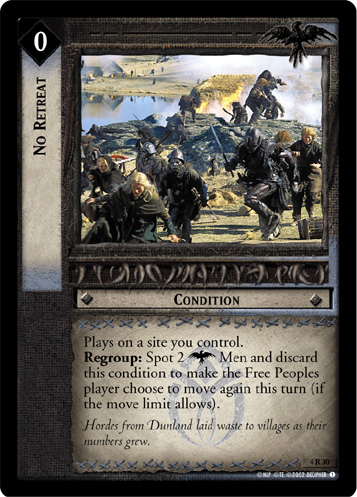 |
Shadow | Dunland | Condition | Plays on a site you control.
Regroup: Spot 2 |
Hornburg Wall (5U118)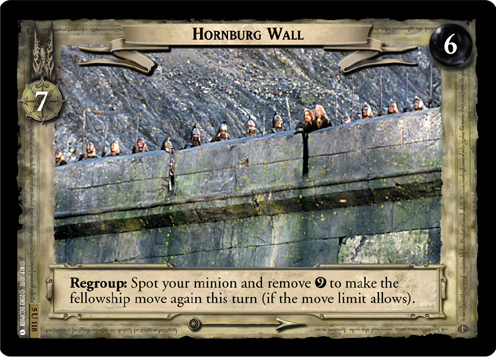 |
None | Site | Site | Regroup: Spot your minion and remove |
Osgiliath Channel (8U120)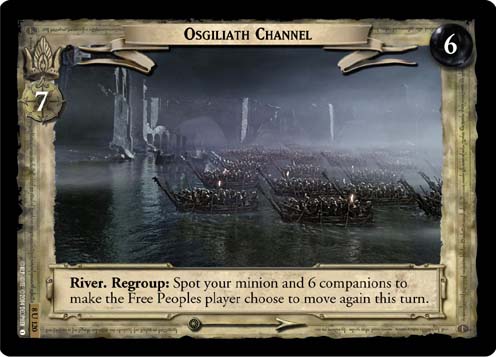 |
None | Site | Site | River. Regroup: Spot your minion and 6 companions to make the Free Peoples player choose to move again this turn. |
Forced March (13R108)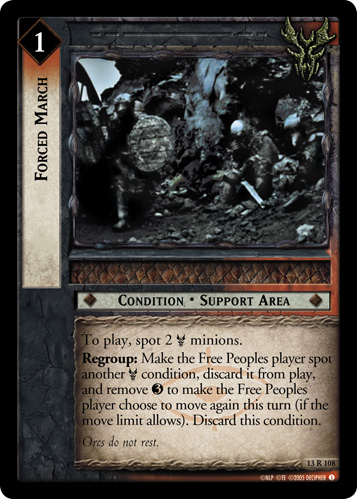 |
Shadow | Orc | Condition | To play, spot 2 |